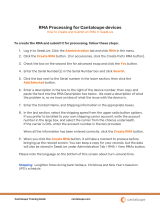
A-61796 December 2013 1-3
Setting up
configurations
You must configure the Scan Station using the Kodak Scan Station 700/
720EX - Scanner Administration application before you can use it. The
application allows you to configure and manage your Scan Stations.
A Scan Station configuration consists of setting the following groups of
options: Device Settings, Scan Settings, Destinations, Groups, and
Jobs. These options are accessible via the Configuration tab on the
Scan Station 700/720EX - Scanner Administration application using the
Edit menu.
• Device Settings — consists of the following configuration items. See
Chapter 4 for more information.
- Device Options: used to configure the Scan Station (e.g., display
language, date, time, etc.).
- Email Server: used to configure the Scan Station to use an
SMTP server. Configuration of an email server is required if you
will be sending documents to an email destination.
- Active Directory Server: used to configure the location of an
Active Directory Server. This will be required if you want to define
users and groups of users from your Active Directory Server.
- Fax: used to configure fax options. Fax configuration will be
required if you will be sending scanned documents via fax.
• Scan Settings — allows you to define items that determine how a
document will be scanned (e.g., black and white, two sided, 300 dpi,
etc.), the output format (e.g., PDF, JPEG, XLS, etc.), any special
processing, and how to name the scanned document. Multiple scan
settings can be configured. For example, you can setup a scan
setting configuration for scanning color documents, and another scan
setting configuration for scanning black and white documents. After
defining your scan setting configuration, you will be prompted to
name your configurations for later use. See Chapter 5 for more
information.
• Destinations — allows you to define where the scanned image(s) is
sent or stored. The Scan Station can send or store documents to
email, a network folder, printer, FTP, fax, email to fax, SharePoint,
and Kofax Front Office Server. For example, you could define a
destination named Invoices that sends scanned documents to
SharePoint and a printer; and define another destination named
Purchase Orders that only sends scanned documents to SharePoint.
After defining your destinations, you will be prompted to name your
destinations for later use. See Chapter 6 for more information.
• Groups — groups are used to control access to jobs for specific
users or groups of users. See Chapter 7 for more information.
• Jobs — jobs are a combination of Scan Settings, Destinations and
Groups. A job is represented on the Scan Station user interface as a
single button, such as Invoices. A job allows one touch scanning
since a job will define how a document should be scanned and
formatted (Scan Settings), where the document should be stored or
sent (Destinations), and the users or groups of users that are allowed
to use a particular job (Groups). See Chapter 8 for more information.




















